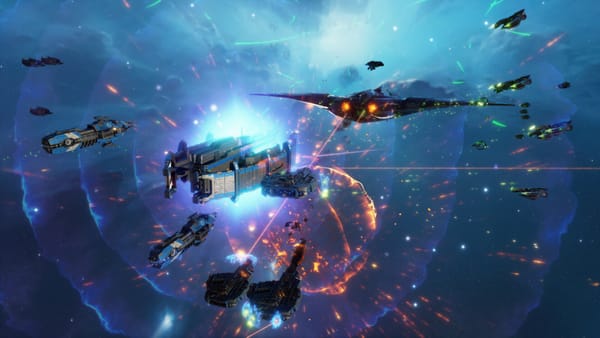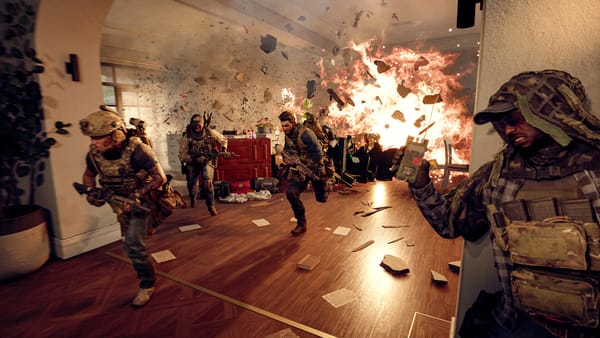Sins of a Solar Empire II



More than 15 years after Sins of a Solar Empire and more than 12 years after Sins of a Solar Empire: Rebellion, Ironclad and Stardock have released the 4X RTS Sins of a Solar Empire II. What are they up to in this niche genre?
Sins of a Solar Empire II is a mix of RTS and 4X space strategy. Players take control of one of three races, each with two sub-factions with different play styles, and begin to expand in the universe: colonise celestial bodies, build fleets, research two tech trees (military and civilian), specialise planets, jump to other systems using phase lanes, and fight for supremacy in large-scale battles - all in real time, with a seamless, spectacular zoom feature to keep track of everything from the global view down to the turrets on spaceships.
The three races are also very different. The TEC (Trader Emergency Coalition) are humans who have banded together to fight the alien Vasari Empire. They rely heavily on trade to support their industrial base and increase their resource income. Shields are a late development, but their ships have robust armour. The Vasari are a fallen empire on the run from an unknown enemy. They use their mastery of phase space to conquer and acquire resources to continue their exodus. One of the sub-factions therefore relies on mobility and moves from star system to star system. They don't use credtis, but metal and crystals for construction - and collect phase resonance for mobility, combat and utility. The Advent are a civilisation of humans who were forcibly exiled by the Traders and have returned with technologically enhanced psionics and the power of their collective will, called Unity, with powerful abilities such as psi-scanning or fleet recall to the home system. Their ships have strong shields but weak armour. Each faction has a Titan battleship with special abilities and experience levels, as well as various planetary items that provide bonuses.
Although there are basic diplomatic options, the game is ultimately about big battles - there are no research, economic or cultural victories like in other 4X games. It also doesn't have the emergent stories through narrative events like in Stellaris. At first glance, the gameplay looks very similar to its predecessor, but apart from the technical and graphical improvements, a lot has changed in the details, especially in the physics simulation. Turrets with their own pitch and tracking speeds make firing solutions important in battles. Fully simulated missiles can be blocked by ships or destroyed by point defences. This can even lead to ships being deliberately sacrificed and placed in the line of fire to protect important targets. However, there are no classic fleet formations. However, planetary surfaces, capital ships, titans and starbases can also be customised and specialised.
As the interplanetary empire grows, the management becomes more complex. However, there are many clever automations that make this easier. Research and the activation of capital ship abilities can be automated, while built scouts go on reconnaissance missions on their own. Stardock: "The new fleet system includes the ability to request specific reinforcements on the fly. Requested units are automatically queued from the optimal factory and rallied to the fleet. (...) The Intelligent Construction system will queue up the entire chain of prerequisites to fulfill any item, research, or unit build request." So it's less about micromanagement and more about the big picture, but players can still intervene at any time. This takes a lot of the more complex systems out of the equation and makes the game a little more accessible to new players and casual gamers - who can also compete against the AI in lower difficulty levels or against other players in multiplayer.
However, the spectacular battles are often a little too static, as was the case in its predecessor. There may be more small spaceships scurrying around. But thanks to dynamic lighting and physics-based rendering, the battles are truly impressive. The multi-core 64-bit engine is also said to be able to 'utilise all available cores and RAM to maximize performance'.
The galaxy simulation is dynamic, with planets orbiting their stars in real time, slowly changing the structure of the galaxy and creating new battle fronts and opportunities. The system is designed for the long haul, however, as the changes will take a long time to make, but can provide the odd surprise. The developers give the following example: "Build a secondary fleet on a rogue asteroid and launch a devastating surprise attack when its orbit brings it behind the enemy's back line". And there are minor factions that populate the galaxy, offering trade, auctions for rare items and, with enough influence, access to their most powerful abilities, whereby these could offer a few more options.
Sins of a Solar Empire II entered Early Access in October 2022, exclusively on the Epic Games Store. After a few content updates, but still without the third faction (Advent), the game almost quietly left Early Access. It grew in size and only came to the forefront with the launch on Steam on 15 August 2024. However, Ironclad Games Corporation and Stardock Entertainment see the game as a long-term platform and have already announced four expansions. The first, Path of Power, was recently released - more on that later. The second DLC will add two more units per race, 'Times of War' (DLC #3) promises a story-driven single-player campaign, and 'Harbinger' (DLC #4) will add a fourth race.
"Path of Power features ten scenario maps with objective-based challenge missions, each with its own set of victory conditions - defending a home planet from invaders, for example, or assimilating the galaxy's human population as the Advent. Nothing more, nothing less, but not really a replacement for the campaign, more like little appetizers. Along with the DLC comes Update 1.4. This update reintroduces the population mechanic from the original Sins of a Solar Empire. The culture of the empire will determine the loyalty of its people, giving players bonus resources or debuffs based on the loyalty of their citizens.
"With Paths to Power, we set out to create wholly unique gameplay scenarios where players will create strategies they've never used before in Sins II," said Brian Clair, Executive Producer at Stardock. "In addition to this great new DLC pack, we get to bring a free new update to all players with Update v1.4 featuring the return of Population, as well as new units and planet types!"
The game is being developed by Ironclad Games of Canada. Founded in 2003, the studio has 'only' released three games to date. These include Sins of a Solar Empire (2008) with numerous expansions and the stand-alone title Sins of a Solar Empire: Rebellion, the MOBA Sins of a Dark Age (2015), which was cancelled after less than a year, and last but not least Sins of a Solar Empire II (2022). Co-developer and publisher is Stardock Entertainment, based in Plymouth, Michigan. The company was founded in 1991 and is known for strategy games such as Galactic Civilizations, The Political Machine and Elemental.
Sins of a Solar Empire II is a unique 4X RTS with spectacular space battles for sandbox strategists who want to go into combat. The single player campaign and a fourth faction will follow later as DLC.








